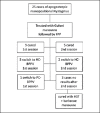The clinical significance of direction-fixed mono-positional apogeotropic horizontal nystagmus
- PMID: 35880369
- PMCID: PMC9330750
- DOI: 10.14639/0392-100X-N1824
The clinical significance of direction-fixed mono-positional apogeotropic horizontal nystagmus
Abstract
Objective: A mono-positional persistent, direction-fixed apogeotropic nystagmus (MPosApoNy) is very challenging for the neuro-otologist. MPosApoNy can be found in patients suffering from a partially compensated acute unilateral vestibulopathy; with a normal caloric test, one can speculate the presence of "trapped" otolithic debris located close to the ampulla of the horizontal semicircular canal.
Methods: Among 957 patients suffering from vertigo and dizziness, we selected 53 cases of MPosApoNy.
Results: In 28 patients, caloric test showed a canal paresis on the same side of the MPosApoNy. In the remaining 25 cases, MPosApoNy was the only clinical finding. We hypothesised the presence of horizonal canal lithiasis and patients were treated with a Gufoni manoeuvre, followed by a forced prolonged position.
Conclusions: Performing bedside examination in a patient suffering from vertigo, the presence of MPosApoNy may be due to: a) facilitation of a subclinical nystagmus due to the mechanism of apogeotropic reinforcement; b) horizontal canal lithiasis with 'trapped' otoliths close to the ampulla. The disappearance of MPosApoNy following a repositioning manoeuvre or conversion in a typical form of canalolithiasis may represent the best method to confirm this hypothesis.
Il significato clinico del nistagmo monoposizionale orizzontale apogeotropo.
Obiettivo: Il riscontro di un nistagmo monoposizionale orizzontale apogeotropo (MPosApoNy) rappresenta una sfida diagnostica per il vestibologo. Tale nistagmo può indicare, in presenza di un deficit al test calorico, una labirintopatia periferica non compensata. In assenza di tale reperto, il MPosApoNy potrebbe essere riconducibile ad una forma atipica di litiasi del canale semicircolare orizzontale (CSL).
Metodi: Su 957 pazienti con vertigini, ne abbiamo selezionati 53 che presentavano MPosApoNy.
Risultati: In 28 pazienti il test calorico evidenziò un deficit ipsilaterale al MPosApoNy. Nei rimanenti 25 in cui il test calorico risultò nella norma, si ipotizzò una litiasi del CSL con otoliti intrappolati in prossimità dell’ampolla. Questi pazienti vennero trattati con manovra di Gufoni e successiva posizione coatta.
Conclusioni: Il riscontro di un MPosApoNy può riconoscere una duplice causa. Esso può essere l’espressione di un nistagmo subclinico esito di labirintopatia acuta monolaterale. Tuttavia, la presenza di otoliti intrappolati in stretta vicinanza dell’ampolla ne può spiegare la genesi. In quest’ultimo caso, le manovre liberatorie, attraverso la risoluzione del MPosApoNy o per la conversione in una forma tipica di canalolitiasi, possono confermarne l’origine litiasica.
Keywords: apogeotropic nystagmus; benign paroxysmal positional vertigo; canalolithiasis; horizontal semicircular canal; positional nystagmus.
Copyright © 2022 Società Italiana di Otorinolaringoiatria e Chirurgia Cervico-Facciale, Rome, Italy.
Figures


Similar articles
-
Direction-fixed paroxysmal nystagmus lateral canal benign paroxysmal positioning vertigo (BPPV): another form of lateral canalolithiasis.Acta Otorhinolaryngol Ital. 2013 Aug;33(4):254-60. Acta Otorhinolaryngol Ital. 2013. PMID: 24043913 Free PMC article.
-
Spontaneous Canalith Jam and Apogeotropic Horizontal Canal Benign Paroxysmal Positional Vertigo: Considerations on a Particular Case Mimicking an Acute Vestibular Deficit.Otol Neurotol. 2018 Oct;39(9):e843-e848. doi: 10.1097/MAO.0000000000001949. Otol Neurotol. 2018. PMID: 30106853
-
Converting apogeotropic into geotropic lateral canalolithiasis by head-pitching manoeuvre in the sitting position.Acta Otorhinolaryngol Ital. 2008 Dec;28(6):287-91. Acta Otorhinolaryngol Ital. 2008. PMID: 19205592 Free PMC article.
-
Benign paroxysmal positional vertigo.Auris Nasus Larynx. 2022 Oct;49(5):737-747. doi: 10.1016/j.anl.2022.03.012. Epub 2022 Apr 3. Auris Nasus Larynx. 2022. PMID: 35387740 Review.
-
Classification, diagnostic criteria and management of benign paroxysmal positional vertigo.Auris Nasus Larynx. 2017 Feb;44(1):1-6. doi: 10.1016/j.anl.2016.03.013. Epub 2016 May 9. Auris Nasus Larynx. 2017. PMID: 27174206 Review.
Cited by
-
Epley's Influence on Horizontal Canal BPPV Variants.Audiol Res. 2025 Mar 7;15(2):25. doi: 10.3390/audiolres15020025. Audiol Res. 2025. PMID: 40126273 Free PMC article. Review.
References
-
- Cawthorne T. Positional nystagmus. Ann Otol Rhinol Laryngol 1954;63:481-490. - PubMed
-
- Eggers SDZ, Bisdorff A, Von Brevern M, et al. . Classification of vestibular signs and examination techniques: nystagmus and nystagmus-like movements: consensus document of the Committee for the International Classification of Vestibular Disorders of the Bárány Society. J Vestib Res 2019;29:57-87. https://doi.org/10.3233/VES-190658 10.3233/VES-190658 - DOI - PMC - PubMed
-
- Fluur E, Siegborn J. The otolith organs and the nystagmus problem. Acta Otolaryngol 1973;76:438-442. https://doi.org/10.3109/00016487309121533 10.3109/00016487309121533 - DOI - PubMed
-
- Wang H, Li Z, Zhang S, et al. . Horizontal nystagmus is gravity-dependent in patients with vestibular neuritis. Am J Otolaryngol 2021;42:1-5. https://doi.org/10.1016/j.amjoto.2021.102967 10.1016/j.amjoto.2021.102967 - DOI - PubMed
-
- Roberts R, Gans R. Background, technique, interpretation, and usefulness of positional/positioning testing. In: Jacobson G, Shepard N, editors. Balance Function Assessment and Management. San Diego, CA: Plural Publishing Inc.; 2008. p.171-196
MeSH terms
LinkOut - more resources
Full Text Sources

